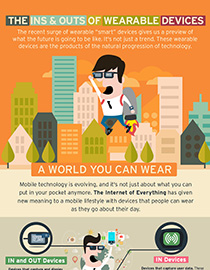Are You Ready For Wearable Devices?
 View infographic: The Ins and Outs of Wearable Devices
View infographic: The Ins and Outs of Wearable Devices
Wearable technology is gaining momentum, and it’s making an indelible impression in the digital realm. With wearable devices, missing out on phone calls, emails, and updates are just few of the things you’ll no longer have to worry about. The quest for convenience, it seems, is becoming a technological feat.
This new wave of interdependent smart devices are functional, reliable, and convenient, not to mention discreet. A good example would be fitness trackers. Designed to look like ordinary bracelets, these smart devices are equipped with biosensors that can measure your body’s data and compute your real-time progress without disrupting your regular workout routine. With the addition of Bluetooth, updates are sent to your mobile device so you know exactly where you left off.
Smart watches, on the other hand, are engineered to serve as extensions of your smartphones. They function like normal digital watches, but they have the added ability of displaying incoming notifications from your smartphone. Many early adopters of smart watches claim that their gadget saves them the trouble of physically checking their phones while they’re busy doing something else. Though the current function of these watches seem rudimentary, electronics companies have already promised the development of more useful and productive apps for smart watches in the near future.
Rounding out these intelligent devices are smart glasses. If fitness trackers and smart watches allow you to keep your real and online life in sync, smart glasses enable you to capture the world in a glimpse. They can help you search online, record data, videos and images, make calls, and send messages, all with a simple voice command. Like other bleeding-edge technologies, this particular wearable still has a lot to prove, since it has yet to reach its maturity. Despite the strengths of its technical specs, it still needs to be developed.
But as much as these smart devices are revolutionary, they can also be intrusive, distracting, and unsafe. Since these devices gather and transmit sensitive data—like your health progress and daily route via fitness trackers, or your messages via smart watches, or your exact location and what it looks like via smart glasses—they also give cybercriminals new targetsto take advantage of. If the bad guys manage to intercept your data, they can steal your identity. And if you use these devices at work, they could use it to get a foot in your work network. When using these smart devices, you need to ask yourself just how much of your privacy are you willing to give up for the price of ease and connectivity.
The infographic above illustrates the three different types of wearable devices in terms of how they send and receive data: In devices that collect and store data locally, Out devices that display user notifications sent by a paired device, and In and Outdevices that can send, receive, and display data. Click on the image above to view the full infographic on wearable devices.

Like it? Add this infographic to your site:
1. Click on the box below. 2. Press Ctrl+A to select all. 3. Press Ctrl+C to copy. 4. Paste the code into your page (Ctrl+V).
Image will appear the same size as you see above.
 Complexity and Visibility Gaps in Power Automate
Complexity and Visibility Gaps in Power Automate AI in the Crosshairs: Understanding and Detecting Attacks on AWS AI Services with Trend Vision One™
AI in the Crosshairs: Understanding and Detecting Attacks on AWS AI Services with Trend Vision One™ Trend 2025 Cyber Risk Report
Trend 2025 Cyber Risk Report The Road to Agentic AI: Navigating Architecture, Threats, and Solutions
The Road to Agentic AI: Navigating Architecture, Threats, and Solutions